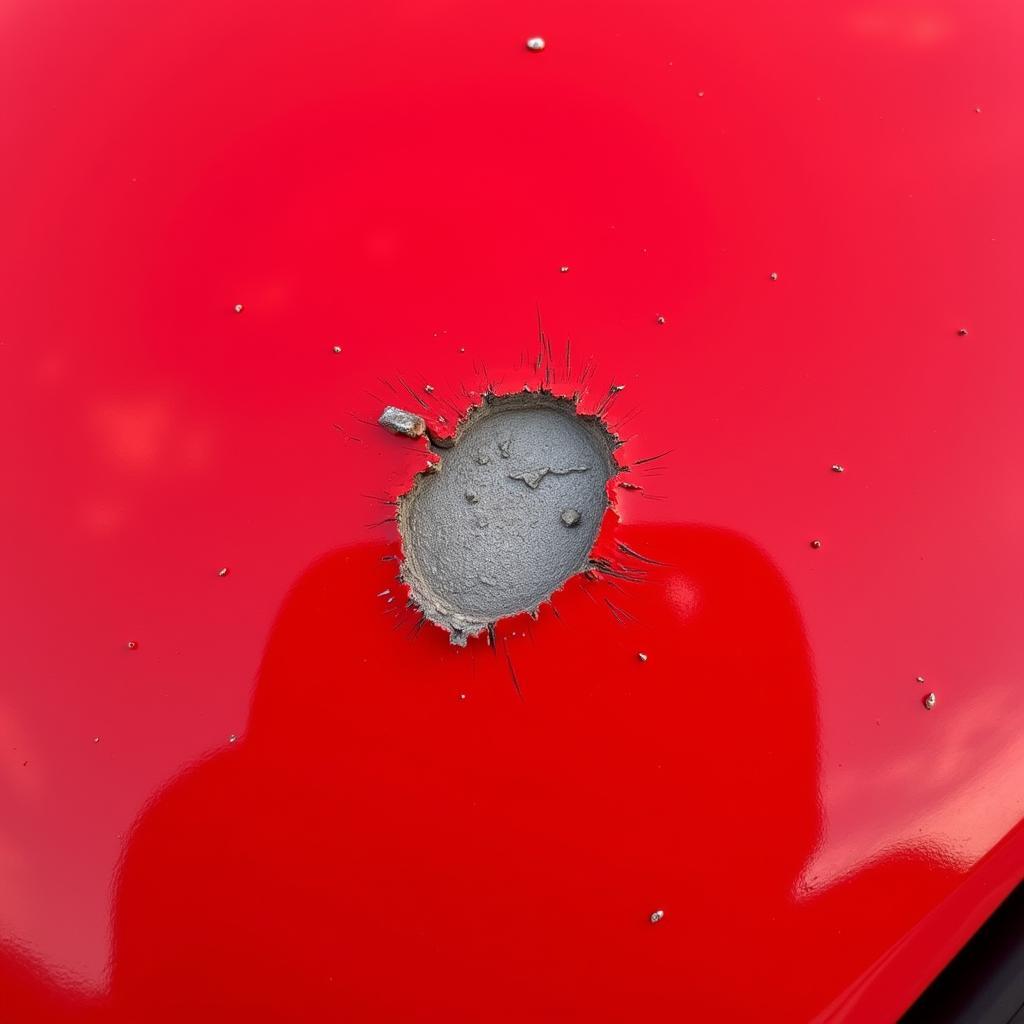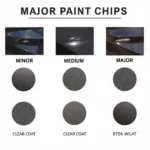Rock chips on your car hood are an unfortunate reality of driving. These small blemishes, caused by flying debris, can quickly turn into larger problems if left untreated. This guide will show you how to repair rock paint damage on your car hood effectively, saving you costly professional repairs and keeping your vehicle looking its best.
Identifying the Extent of the Damage
Before starting any repair, assess the damage. A minor chip, affecting only the clear coat, requires a different approach than a deep chip that exposes the metal underneath. Knowing the severity of the damage will help you choose the right repair method. Is it a small scratch, a chip that has reached the primer, or has the impact exposed bare metal? This will determine the materials and steps involved in the repair. A minor chip might only need touch-up paint, while a deeper one might require primer and clear coat.
After you wash and dry the damaged area, use a magnifying glass to get a closer look at the chip. This will help you accurately assess the extent of the damage. Remember, a small chip can quickly lead to rust if not addressed promptly. Taking the time to properly evaluate the damage now will save you headaches down the road.
Gathering Your Repair Materials
Once you understand the damage, gather the necessary supplies. For minor chips, you’ll need touch-up paint, rubbing compound, and polishing cloth. Deeper chips require primer, sandpaper, masking tape, and clear coat in addition to the touch-up paint. Investing in quality materials ensures a better and more durable repair.
Essential Tools and Materials
- Touch-up paint (matched to your car’s color code)
- Primer (if bare metal is exposed)
- Clear coat (if needed)
- Fine-grit sandpaper (e.g., 2000-grit)
- Rubbing compound
- Polishing cloth
- Masking tape
- Applicator tool (brush or pen)
- Wax and grease remover
- Soft cotton swabs
Repairing the Rock Chip: A Step-by-Step Guide
Clean the area thoroughly with soap and water, then dry it completely. If the chip has reached the bare metal, apply a thin layer of primer. Allow the primer to dry completely before proceeding. Next, apply the touch-up paint in thin layers, allowing each layer to dry before applying the next. Avoid applying too much paint at once, as this can lead to runs and drips.
Applying Touch-up Paint
Patience is key when applying touch-up paint. Multiple thin coats create a smoother, more professional-looking finish.
- Clean the area with wax and grease remover.
- Apply touch-up paint to the chip using a fine-tipped brush or touch-up pen.
- Let each layer dry completely before applying the next.
Sanding and Polishing
Once the paint is completely dry, use fine-grit sandpaper to carefully level the repaired area with the surrounding paint. Follow this with rubbing compound and polishing cloth to restore the shine. This blending process ensures a seamless repair.
Preventing Future Rock Chips
While you can’t entirely eliminate the risk of rock chips, you can minimize it by maintaining a safe following distance, avoiding driving on gravel roads whenever possible, and considering a clear protective film for your hood. Regular waxing also helps to protect your car’s paint.
Conclusion
Repairing rock chips on your car hood is a manageable DIY project that can save you money and maintain your car’s appearance. By following these steps and using the right materials, you can effectively address rock paint damage and keep your car looking its best.
how to repair paint chips on a car
FAQ
- How long does touch-up paint take to dry?
- Can I use nail polish as touch-up paint?
- How do I match my car’s paint color?
- Should I wax my car after repairing a rock chip?
- What if the rock chip is very deep?
- How can I prevent rock chips on my hood?
- Is it necessary to use primer for small chips?
Need help? Contact us via WhatsApp: +1(641)206-8880 or email [email protected]. Our customer service team is available 24/7.



